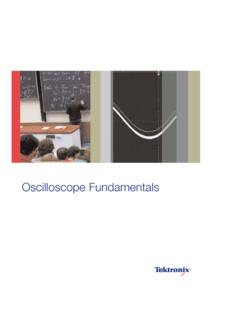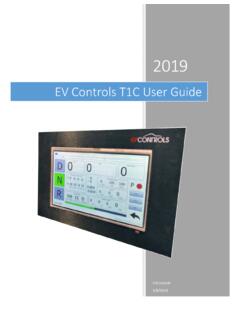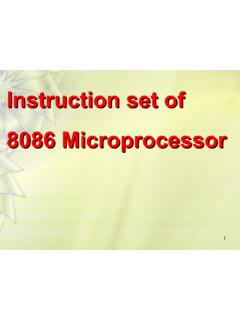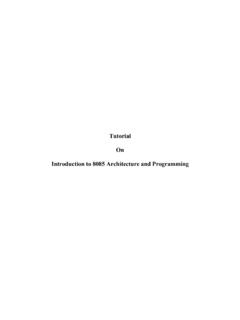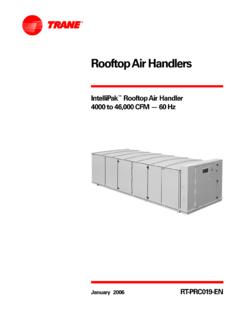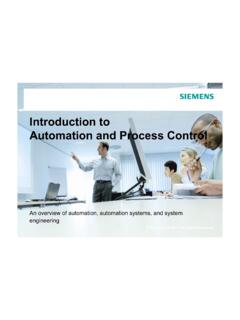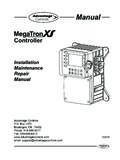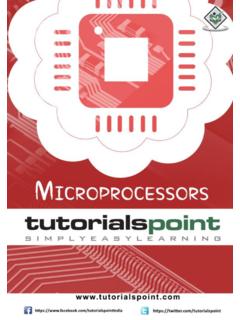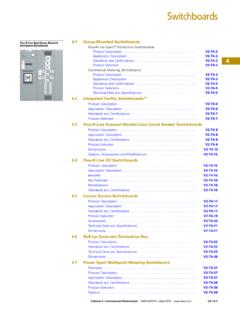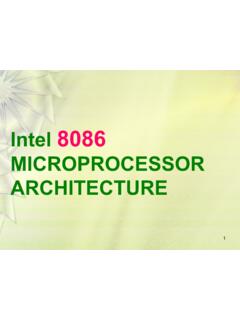Transcription of Oscilloscope Fundamentals - Case School of Engineering
1 Oscilloscope 3/31/09 1:55 PM Page 1 Oscilloscope of ContentsIntroduction .. 4 Signal Integrity .. 5 - 6 The Significance of Signal Integrity .. 5 Why is Signal Integrity a Problem? .. 5 Viewing the Analog Orgins of Digital Signals .. 6 The Oscilloscope .. 7 - 11 Understanding Waveforms & Waveform Measurements ..7 Types of Waves .. 8 Sine Waves .. 9 Square and Rectangular Waves .. 9 Sawtooth and Triangle Waves .. 9 Step and Pulse Shapes .. 9 Periodic and Non-periodic Signals .. 10 Synchronous and Asynchronous Signals .. 10 Complex Waves .. 10 Eye Patterns .. 10 Constellation Diagrams .. 11 Waveform Measurements ..11 Frequency and Period ..11 Voltage .. 11 Amplitude .. 12 Phase .. 12 Waveform Measurements with Digital oscilloscopes 12 Types of oscilloscopes .
2 13 - 17 Digital oscilloscopes .. 13 Digital Storage oscilloscopes .. 14 Digital Phosphor oscilloscopes .. 15 Digital Sampling oscilloscopes .. 17 The Systems and Controls of an Oscilloscope .18 - 31 Vertical System and Controls .. 19 Position and Volts per Division .. 19 Input Coupling .. 19 Bandwidth Limit .. 19 Bandwidth Enhancement .. 20 Horizontal System and Controls .. 20 Acquisition Controls .. 20 Acquisition Modes .. 20 Types of Acquisition Modes .. 21 Starting and Stopping the Acquisition System .. 21 Sampling .. 22 Sampling Controls .. 22 Sampling Methods .. 22 Real-time Sampling .. 22 Equivalent-time Sampling .. 24 Position and Seconds per Division .. 26 Time Base Selections .. 26 Zoom .. 26XY Mode .. 26Z Axis .. 26 XYZ Mode .. 26 Trigger System and Controls.
3 27 Trigger Position .. 28 Trigger Level and Slope .. 28 Trigger Sources .. 28 Trigger Modes .. 29 Trigger Coupling .. 30 Trigger Holdoff .. 30 Display System and Controls .. 30 Other Oscilloscope Controls .. 31 Math and Measurement Operations .. 3/31/09 1:55 PM Page 2 Oscilloscope Complete Measurement System .. 32 - 34 Probes .. 32 Passive Probes .. 32 Active and Differential Probes .. 33 Probe Accessories .. 34 Performance Terms and Considerations .. 35 - 43 Bandwidth .. 35 Rise Time .. 36 Sample Rate .. 37 Waveform Capture Rate .. 38 Record Length .. 39 Triggering Capabilities .. 39 Effective Bits .. 39 Frequency Response .. 39 Vertical Sensitivity .. 39 Sweep Speed .. 40 Gain Accuracy .. 40 Horizontal Accuracy (Time Base) .. 40 Vertical Resolution (Analog-to-digital Converter).
4 40 Connectivity .. 40 Expandability .. 41 Ease-of-use .. 42 Probes .. 43 Operating the Oscilloscope .. 44 - 46 Setting Up .. 44 Ground the Oscilloscope .. 44 Ground Yourself .. 44 Setting the Controls .. 44 Instrument Calibration .. 45 Using Probes .. 45 Connecting the Ground Clip .. 45 Compensating the Probe .. 46 Oscilloscope Measurement Techniques .. 47 - 51 Voltage Measurements .. 47 Time and Frequency Measurements .. 48 Pulse Width and Rise Time Measurements .. 48 Phase Shift Measurements .. 49 Other Measurement Techniques .. 49 Written Exercises .. 50 - 55 Part IA. Vocabulary Exercises .. 50B. Application Exercises .. 51 Part IIA. Vocabulary Exercises .. 52B. Application Exercises ..53 Answer Key ..55 Glossary .. 56 - 3/31/09 1:55 PM Page 3 Oscilloscope FundamentalsIntroductionNature moves in the form of a sine wave, be it an oceanwave, earthquake, sonic boom, explosion, sound through air,or the natural frequency of a body in motion.
5 Energy, vibratingparticles and other invisible forces pervade our physical uni-verse. Even light part particle, part wave has a fundamen-tal frequency, which can be observed as color. Sensors can convert these forces into electricalsignals that you can observe and study with anoscilloscope. oscilloscopes enable scientists,engineers, technicians, educators and others to see events that change over are indispensable tools for anyone designing,manufacturing or repairing electronic equipment. In today sfast-paced world, engineers need the best tools available tosolve their measurement challenges quickly and the eyes of the engineer, oscilloscopes are the key tomeeting today s demanding measurement usefulness of an Oscilloscope is not limited to the worldof electronics. With the proper sensor, an Oscilloscope canmeasure all kinds of phenomena.
6 A sensor is a device thatcreates an electrical signal in response to physical stimuli,such as sound, mechanical stress, pressure, light, or heat. Amicrophone is a sensor that converts sound into an electricalsignal. Figure 1 shows an example of scientific data that canbe gathered by an are used by everyone from physicists to television repair technicians. An automotive engineer uses an Oscilloscope to correlate analog data from sensors with serial data from the engine control unit. A medicalresearcher uses an Oscilloscope to measure brain waves. The possibilities are concepts presented in this primer will provide you with a good starting point in understanding Oscilloscope basicsand glossary in the back of this primer will give you definitionsof unfamiliar terms. The vocabulary and multiple-choice written exercises on Oscilloscope theory and controls makethis primer a useful classroom aid.
7 No mathematical or elec-tronics knowledge is necessary. After reading this primer, you will be able to:Describe how oscilloscopes workDescribe the differences between analog, digital storage,digital phosphor, and digital sampling oscilloscopesDescribe electrical waveform typesUnderstand basic Oscilloscope controlsTake simple measurementsThe manual provided with your Oscilloscope will give youmore specific information about how to use the oscilloscopein your work. Some Oscilloscope manufacturers also providea multitude of application notes to help you optimize theoscilloscope for your application-specific you need additional assistance, or have any comments or questions about the material in this primer, simply contact your Tektronix representative, or visit CellLight SourceFigure 1. An example of scientific data gathered by an 3/31/09 1:55 PM Page 4 Oscilloscope IntegrityThe Significance of Signal IntegrityThe key to any good Oscilloscope system is its ability toaccurately reconstruct a waveform referred to as signalintegrity.
8 An Oscilloscope is analogous to a camera that captures signal images that we can then observe and interpret. Two key issues lie at the heart of signal you take a picture, is it an accurate picture of whatactually happened?Is the picture clear or fuzzy?How many of those accurate pictures can you take persecond?Taken together, the different systems and performance capa-bilities of an Oscilloscope contribute to its ability to deliver thehighest signal integrity possible. Probes also affect the signalintegrity of a measurement integrity impacts many electronic design until a few years ago, it wasn t much of a problem fordigital designers. They could rely on their logic designs to act like the Boolean circuits they were. Noisy, indeterminatesignals were something that occurred in high-speed designs something for RF designers to worry about.
9 Digital systemsswitched slowly and signals stabilized clock rates have since multiplied by orders ofmagnitude. Computer applications such as 3D graphics,video and server I/O demand vast bandwidth. Much oftoday s telecommunications equipment is digitally based, and similarly requires massive bandwidth. So too does digital high-definition TV. The current crop of microprocessordevices handles data at rates up to 2, 3 and even 5 GS/s(gigasamples per second), while some DDR3 memorydevices use clocks in excess of 2 GHz as well as data signalswith 35-ps rise , speed increases have trickled down to the common IC devices used in automobiles, VCRs, andmachine controllers, to name just a few applications. A processor running at a 20-MHz clock rate may well havesignals with rise times similar to those of an 800-MHzprocessor.
10 Designers have crossed a performance thresholdthat means, in effect, almost every design is a some precautionary measures, high-speed problemscan creep into otherwise conventional digital designs. If a circuit is experiencing intermittent failures, or if it encounterserrors at voltage and temperature extremes, chances arethere are some hidden signal integrity problems. These canaffect time-to-market, product reliability, EMI compliance, and more. These high speed problems can also impact theintegrity of a serial data stream in a system, requiring somemethod of correlating specific patterns in the data with theobserved characteristics of high-speed is Signal Integrity a Problem?Let s look at some of the specific causes of signal degrada-tion in today s digital designs. Why are these problems somuch more prevalent today than in years past?

